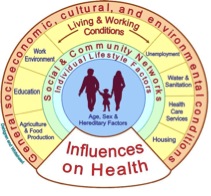Transfer of local public health functions from the NHS to local authorities
The government has proposed to reorganise the way public health services are delivered in England.1 At a National level this will involve the creation of a new body, within the Department of Health, called Public Health England. At a local level, health improvement functions will move into local authorities (LAs) and will be allocated a ring fenced budget. This summary will review the evidence behind the transfer of health improvement functions from the NHS into local authorities.
The term ‘health improvement’ describes activities that aim to improve health and reduce health inequalities by influencing the wide range of factors that determine health (see figure 1).2
Public health was historically based in LAs until it was placed within the NHS during a local government reorganisation in 1974.3 At a local and national level, there have been huge political and social changes since 1974 making the utility in comparative studies of the previous changes questionable. The LAs that public health will return to will be different in both structure and in certain key functions, for example they no longer build council housing.
Evidence of the possible benefits:
Historically, the most significant factors that have improved life expectancy have not been achieved through health services but through public health interventions.1 Indeed, in the 1970s McKeown argued that curative medical measures played little role in the declining death rates.4
In a recent independent review into evidence based strategies to tackle health inequalities, the findings clearly demonstrated that the social determinants of health (see figure 1) are of primary importance.5 It is clear that the social determinants of health mainly lie outside of the NHS remit but fit more closely with the functions of LAs, so moving health improvement functions might seem logical.
Figure 1 – The main factors influencing health6
In recent years, actions have been take to improve joint working between the NHS and LAs on Public Health issues. Most senior public health leaders, called Directors of Public Health (DsPH) have joint posts in the NHS and LAs, although the extent to which they work truly across the two organisations varies. 7 A report commissioned by the last government which considered cost-effective measures for prevention and health improvement strongly advocated closer LA and NHS working.8
Evidence of the possible risks:
By moving public health under the control of the Secretary of State at a national level and into local authorities at a local level, concerns have been raise of the increased politicisation of the public health environment, with a risk of a loss of independence of the public health workforce.9
Local governments vary in structure and, whilst many in England are now unitary authorities, some remain two-tier structures. This could pose some difficulties for public heath teams as key partners operate in both tiers.10
In addition, public health functions have been reorganised many times before and these previous reorganisations have been associated with a loss of experienced staff.9 Further, LAs are under considerable financial pressure and there is already evidence that some plan to use the ring-fenced public health budget to help achieve their savings targets.11
Any implications for health & well-being:
Given the systematic scale of the change and the unique nature of the NHS, there is little clear evidence that the proposed shift of responsibilities will improve health and well-being outcomes for the population.
If the shift heralds a move towards a more social-determinant focused approach then improvements could be expected in both health and health inequalities, but with the clear focus on individual responsibility for health outlined in the white paper,1 it is not implicit that this will be the result of the proposed structural changes.
A key risk is the uncertainty of the resourcing that will be available and how it will be protected. Without sufficient resources, the effective delivery of any Public Health function will be reduced.
Author: Tim Madelin, Senior Public Health Strategist, NHS East London and the City
UK area affected: England only
References/Further reading
1 Department of Health. White paper. Healthy Lives, Healthy People: Our strategy for public health in England 2010;Available from: http://www.dh.gov.uk/prod_consum_dh/groups/dh_digitalassets/@dh/@en/@ps/documents/digitalasset/dh_122347.pdf
2 Faculty of Public Health. Public Health: Specialise in the bigger picture. http://www.fph.org.uk/uploads/ph_careers_booklet.pdf Accessed 05/05/11
3 Baggott, R. 2000 Public Health: Policy and Politics. Basingstoke: Pagrave MacMillan
4 McKeown T. The Modern Rise of Population. London: Edward Arnold, 1976
5 Fair Society, Healthy Lives – The National Strategic Review of Health Inequalities 2010; http://www.marmotreview.org/
6 Figure adapted from G Dahlgren and M Whitehead, Policies and strategies to promote social equity in health, Institute of Futures Studies, Stockholm, 1991 available at http://www.framtidsstudier.se/filebank/files/20080109$110739$fil$mZ8UVQv2wQFShMRF6cuT.pdf
7 Hunter D. J. ed, Perspectives on Joint Director of Public Health Appointments, I&DeA, 2008 http://www.idea.gov.uk/idk/aio/9275054
8 Wanless D, Securing Good Health for the Whole Population; Final Report; London, HMSO, 2004
9 Faculty of Public Health response to the public health white paper
http://www.fph.org.uk/uploads/FPH%20response%20to%20Healthy%20Lives,%20Healthy%20People%20-%20Our%20strategy%20for%20public%20health%20in%20England%20-%20FINAL.pdf
10 Chartered Institute of Environmental Health response to the public health white paper
http://www.cieh.org/uploadedFiles/Core/Policy/CIEH_consultation_responses/Response%20to%20the%20Public%20Health%20White%20Paper.pdf
11 http://www.hsj.co.uk/comment/opinion/sally-gainsbury-scary-care-cuts/5028638.article


Leave a Reply